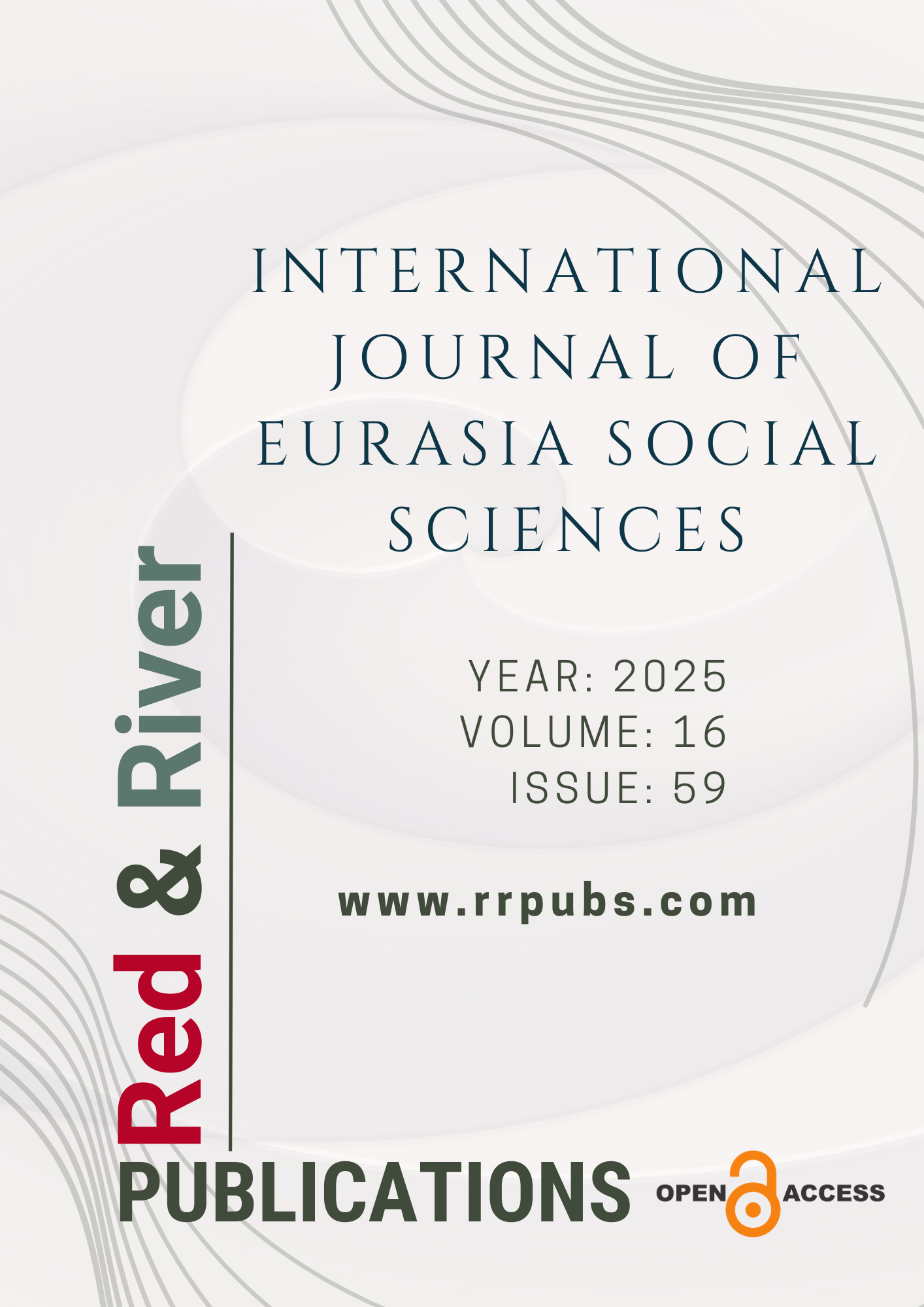Mythological analysis of symbols in Gustav Klimt’s works
DOI:
https://doi.org/10.70736/ijoess.562Keywords:
Gustav Klimt, symbolism, mythology, art nouveauAbstract
This research provides a roadmap for understanding the mythological origins of the symbols in Klimt’s works. In the research, the works of Gustav Klimt, Pallas Athena (1898), Judith and the Head of Holofernes (1901), Portrait of Adele Block-Bauer 1 (1903-1907) and Hygeia (1907) were examined contextually. The works, the most frequently repeated mythological references and the mythological narratives on which these references are based, the female figures in the works and the mythological female characters they are associated with, the most frequently repeated symbols and the relationship of these symbols with mythology were examined. Content analysis method was used in the research, and the data obtained through the relevant literature review was evaluated. The research was limited to the artist’s works on mythology and women’s themes. The research offers new perspectives on how Klimt’s art can be evaluated both within the cultural and social context of his time and within today’s understanding of art. As a result of the research, a better understanding of the structure of symbolism in Klimt’s works has been achieved, and the analyses made from a mythological perspective have revealed the depths of Klimt’s works and shown that the artist touched on universal themes that extended beyond his own time. According to the research results, Klimt was greatly inspired by the mythological elements of different cultures in his paintings. He mostly included symbols and myths from Greek and Japanese mythology in his paintings. When we look at the context of the subject, we see that he frequently uses the theme of women. It can be said that it can be a suggestion for different researches, especially in terms of choosing goddess figures rather than God depictions in mythology.
References
Antos, A. (2015). Gustav Klimt’s athena department of art history, College of Visual and Performing Arts, Northern Illinois University. Öğrenci Katılım Projeleri. 42.
Ayaydın, A. (2015). Art nouveau akımına 21.yüzyıl perspektifinden bir bakış. Ulakbilge Sosyal Bilimler Dergisi, 3(6), 58-73, https://doi.org/10.7816/ulakbilge-03-06-03
Ayaydın, A. (2017). Sembolizm akımınına geçmiş ve günümüz perspektifinde bir bakış. Ulakbilge, 5(11), 701-712.
Baş, G. (2024). Adele bloch-bauer ı ve stoclet frizi yapıtlarında bizans mozaiklerinin etkileri ve Gustav Klimt. Sanat Yazıları (50), 46-56, https://doi.org/10.61742/Sanatyazilari.1339792
Bazyar, C. K. (2016). Mitoloji ve çağdaş sanat. Sanat ve Tasarım Dergisi, (18), 113-130.
Büyüköztürk, Ş., Akgün, Ö. E., Demirel, F., Karadeniz, Ş., & Çakmak, E. K. (2015). Bilimsel araştırma yöntemleri. Pegem Akademi. https://doi.org/10.14527/9789944919289
Çoruhlu, Y. (2021). Türk mitolojisinin kısa tarihi. Alfa.
Erbek, Ç. (2012). Sanat tarihi çağlar boyu insan. Yayın B.
Erden, E. O. (2016). Modern sanatın kısa tarihi. Hayalperest Yayınevi.
Finn, B. C., Bruetman, J. E., & Young, P. (2013). Gustav Klimt (1862-1918) y su cuadro sobre la medicina. Revista médica de Chile, 141(12), 1584-1588, http://dx.doi.org/10.4067/S0034-98872013001200013
Florman, L. (1990). Gustav klimt and the precedent of ancient greece. The Art Bulletin, 72(2), 310-326. https://doi.org/10.1080/00043079.1990.10786440
García, J.E. (2008). Symbols and myths. Clinical and Translational Oncology 1, 70–72, https://doi.org/10.1007/s12094-008-0158-0
Geçen, F., & Yazar, T. (2018). Görsel sanatlarda evrensel dil ve sanatsal sembolizm. Journal of International Social Research, 11(61), http://dx.doi.org/10.17719/jisr.2018.2946
Gibson, C. (2013). Semboller nasıl okunur. Yem Yayın.
Göğebakan, Y., & Turan, M. (2022). Sigmund freud’un yüceltme mekanizması bağlamında gustav Klimt’in eserlerindeki erotizm. Academic Social Resources Jornal, 7(36).
Grzymkowski, E. (2017). Sanat 101. Say Yayınları.
Kazanç, N. A. (2018). Gustav Klimt’in kadın portreleri üzerine bir inceleme. Cumhuriyet Üniversitesi Fen-Edebiyat Fakültesi Sosyal Bilimler Dergisi, 42(1), 113-129.
Marlowe, S.T. (2003). “Medicine” by Gustav Klimt. Artibus et Historiae, 231-252, https://www.jstor.org/stable/1483769
Schlesener, E. A. (2021). Re-Creating judith beheading holofernes, originally painted by artemisia gentileschi, in a real-time rendering system. (Master’s Thesis, Clemson University).
Sevim, K. (2019). Gözün sembolik kullanımı ve Türk seramik sanatına yansımaları. İdil Sanat ve Dil Dergisi, 8, http://dx.doi.org/10.7816/idil-08-64-19
Sine, N. (1988). Cases of mistaken identity: Salome and Judith at the turn of the century. German Studies Review, 11(1), 9-29, https://www.jstor.org/stable/1430832
Türe, A., & Öztürk, Ö. T. (2021). The transformation of mythological stories into the art of painting. International Society for Technology, Education and Science. 223-234.
Yener, G. (2017). Gustave Klimt’in ikonaları. Cappadocia Journal of Hıstory and Social Sciences, 8, 110-138, http://dx.doi.org/10.18299/cahij.134
Yenigeldi, M. (2023). 19. yüzyıl batı resim sanatında doğa ve sembolizm. (Master’s thesis, Mimar Sinan Güzel Sanatlar Üniversitesi).
URL-1 05.07.2024 tarihinde https://www-gustav--klimt-com.translate.goog/PallasAthene.jsp?_x_tr_sl=en&_x_tr_tl=tr&_x_tr_hl=tr&_x_tr_pto=tc, sayfasından erişilmiştir.
URL-2 05.07.2024 tarihinde https://www-gustav--klimt-com.translate.goog/Judith-and-the-Head-of-Holofernes.jsp?_x_tr_sl=en&_x_tr_tl=tr&_x_tr_hl=tr&_x_tr_pto=tc#google_vignette, sayfasından erişilmiştir.
URL-3 06.07.2024 tarihinde https://en.wikipedia.org/wiki/List_of_paintings_by_Gustav_Klimt, sayfasından erişilmiştir.
URL-4 07.07.2024 tarihinde https://www-gustav--klimt-com.translate.goog/Portrait-Of-Adele-Bloch-Bauer-1.jsp?_x_tr_sl=en&_x_tr_tl=tr&_x_tr_hl=tr&_x_tr_pto=tc , sayfasından erişilmiştir.
URL-5 11.07.2024 tarihinde https://www-artchive-com.translate.goog/artwork/hygeia-gustav-klimt-1907/?_x_tr_sl=en&_x_tr_tl=tr&_x_tr_hl=tr&_x_tr_pto=tc , sayfasından erişilmiştir.
Downloads
Published
How to Cite
Issue
Section
License
Copyright (c) 2025 Yelda Usal

This work is licensed under a Creative Commons Attribution 4.0 International License.

